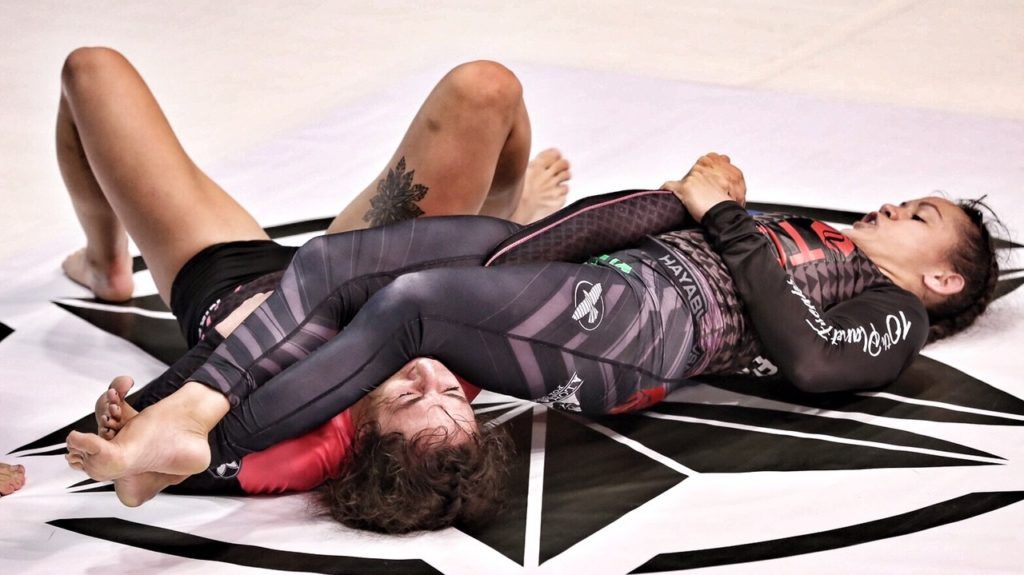Guest post by Evolve MMA, Asia’s premier championship brand for martial arts. It has the most number of World Champions on the planet. Named as the #1 ranked martial arts organization in Asia by CNN, Yahoo! Sports, FOX Sports, Evolve MMA is the top rated BJJ gym in Singapore.
Submitting an opponent is the main goal of every BJJ practitioner because it signifies that the opponent is incapacitated and the match is over. However, since BJJ is like a game of chess, where counter upon counter can be put into play, it’s important to use submission chains that will keep you a step ahead. And as you know, staying one step ahead of your opponent could mean all the difference in who wins the match. Here are some of the most effective submission chains that you will find among all levels of BJJ:
1) Basic guard submission chain
One of the most common and effective guard submission chains is the armbar-omoplata-triangle chain. It is particularly effective because you can start with any of the moves and can cycle back and forth through the positions. It’s so effective that you will be sure to see it whenever you watch high-level tournaments. This particular submission sequence is non-negotiable; every respectable BJJ practitioner is proficient in it or a variant of it. The best part – all of these submissions have probably been part of your arsenal since you started BJJ. None of them should be too difficult for you to execute. Ensure that you can transition seamlessly throughout the chain and watch your submission success improve dramatically!
- Armbar from closed guard
- Triangle – Your opponent pulls the arm out so you step on his hip and launch your other leg over his neck
- Omoplata – Your opponent wraps his inside arm around your leg so you switch to the omoplata
2) Mount submission chain
The full mount is considered one of the most dominant positions in BJJ because it gives a practitioner incredible control and leverage over his or her partner’s body. As we’ve seen from many high-level matches, a deep collar grip from mount is one of the first steps to imposing one’s will from mount. This “triple attack” series starts from a very stable mount position and that same deep collar grip. It is considered one of the most basic submission chains and we’ve seen time again how basics win competitions so make sure you have it in your arsenal!
- Insert deep collar grip to cross choke
- Armbar – Your opponent turns to his side to defend the choke so you attack his top arm
- Collar choke – If the armbar is difficult to finish you may pass his collar to your other hand from behind his back and finish with a collar choke instead
3) Side mount chain
This very basic side mount submission chain is both effective and low risk. It allows you to attack an opponent’s far arm while it is in any of these three angles while maintaining a stable side mount position. This is a perfect sequence to use when maintaining top position throughout the match is a must for you.
- Americana
- Straight armlock
- Kimura
- Armbar
4) Kimura trap
The kimura trap is a full chain of submissions and positions starting from the kimura grip. It is very powerful because it gives you great control over an opponent’s movement while applying a constant threat of a submission. It is so effective that we are starting to see the kimura trap applied even in high-level MMA matches. One example is Davi Ramos’s seamless execution of a rolling kimura back take in UFC 224 against Nick Hein. By securing the kimura, he was able to transition to a rear naked choke and secure the win. The secret to the kimura trap control is in raising your opponent’s elbow whenever he tries to turn in your direction and if he instead chooses to turn away, he ends up giving up his back.
- Lock in the kimura from top position
- Scissor choke with legs – If opponent defends the kimura by securing his arm, you can fall to the mat over his head (if you started in half-guard, you can kick your leg free) and scissor his head with your legs to secure a choke
- Let your opponent face you and take the back – If he tries to sit up or face you, press down on his wrist and raise his elbow to prevent him from facing you. His attempt to get up will separate his back from the mat, giving you space to slide yourself underneath him
- Armbar from the back – With the kimura grip still secure, you now have several options including attempting an armbar, switching to seatbelt, or even finishing the kimura.
5) Headlock chain
The headlock chain is an indispensable sequence, especially for no gi. Once you have control of an opponent’s head, the headlock chain will ensure that you keep control and continue to threaten submissions throughout his attempts to escape. Almost any headlock position (guillotine, arm-in guillotine, anaconda, or d’arce) will lead into the series making it incredibly versatile.
- Guillotine from guard
- Butterfly sweep to mounted guillotine
- Forward roll then anaconda when your opponent gets on all fours
- Arm-in guillotine variation
- Back-take then finish with a rear naked choke


















